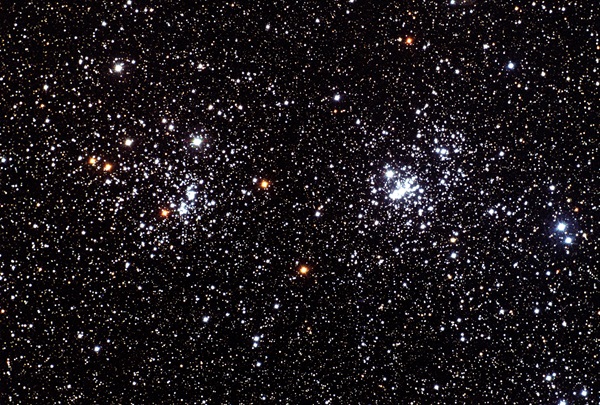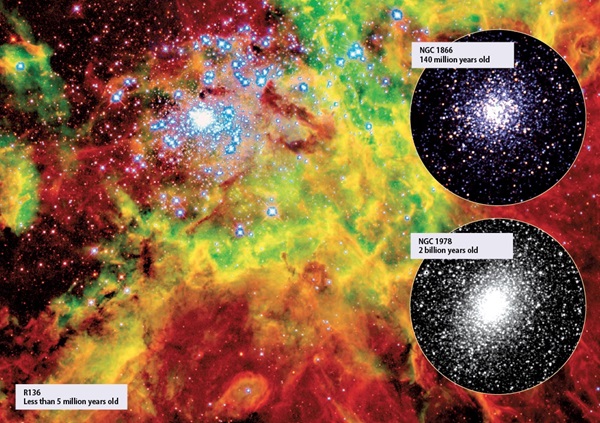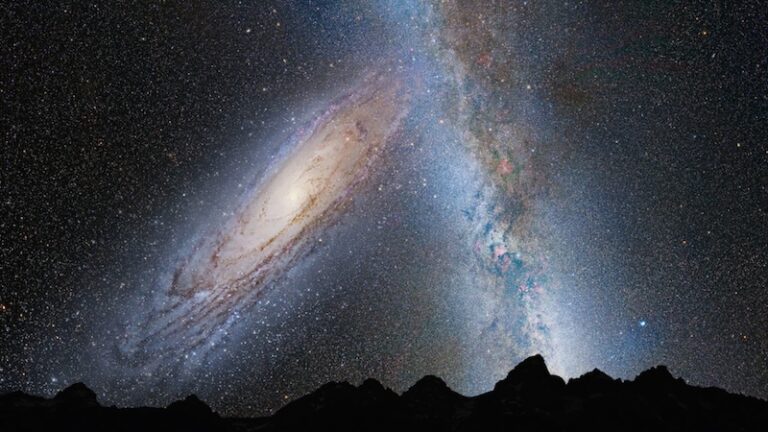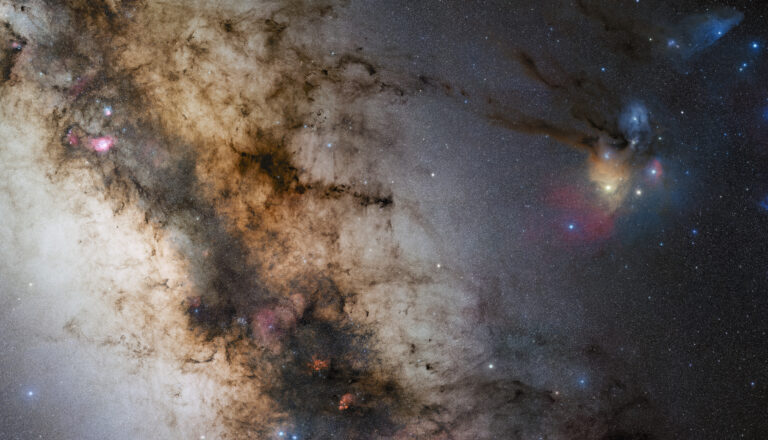One of astronomy’s fundamental concepts is that Earth orbits an average star, which coasts through a nondescript portion of our Milky Way, a typical spiral galaxy.
It’s a notion that harks back to Copernicus — he did, after all, nudge Earth from the center of the universe — but it also dovetails with the natural human tendency to regard those things most familiar to us as normal.
Our location in the Milky Way Galaxy gives astronomers a great opportunity to see how stars live and die. One of the best ways to see this comes from star clusters, groups of newborn and aged stars that hang together and provide important clues about the past.
What has become clear in the past 25 years is that the way astronomers have traditionally characterized star clusters — classing them as either open or globular, the two forms seen in our home galaxy — no longer holds up. Colliding galaxies, or those undergoing intense bursts of star formation, seem filled with objects that don’t easily fit into either category. In the past few years, astronomers have found hard-to-classify clusters even in normal spirals, galaxies otherwise like our own.
Star clusters have been objects of intense study for more than a century. They are the glittering gems of the night sky, aggregations of a few hundred to about a million stars, usually forming a single gravitationally bound entity.
Most stars probably form within clusters, so the problem of understanding star formation is inextricably linked to understanding how clusters form. Clusters are important because they provide a sample of stars at the same age, with about the same chemical content, and at the same distance from Earth — which makes them useful for testing theories of stellar evolution. Because observers can identify and study star clusters in other galaxies at distances where individual stars can no longer be distinguished, astronomers gain insight into star-formation processes across a broad expanse of space and time.
“We live in the Milky Way, and as a result, we have a certain perspective about what we might call a star cluster,” says Rupali Chandar, an astronomer at the University of Toledo, Ohio. In our parochial view, star clusters come in two flavors — open and globular — that at first glance could not be more different.
The view from within
Open clusters reside in our galaxy’s disk, typically contain stars no older than a billion years, and hold a few hundred to perhaps a few thousand solar masses. Their stars exhibit metallicity — the complement of elements heavier than helium — similar to or greater than our Sun’s. Open clusters range in size from several to more than 50 light-years across and appear diffuse and irregularly shaped. About 1,000 have been cataloged, with the most famous examples being the familiar Pleiades and Hyades in Taurus. Thousands more likely exist beyond our ability to detect them.
Globular clusters ride orbits highly inclined to the Milky Way’s disk and are associated with its more spherical halo and bulge components. Globulars typically contain 100,000 solar masses, all of it packed into a spherical or elliptical volume 100 or so light-years across. With ages around 12 billion years, globular clusters are truly ancient objects, a fact reflected in the low metallicity of their stars. About 150 globulars — including several visible to the unaided eye — orbit the Milky Way.
Star clusters in the Andromeda Galaxy, the nearest large spiral, appear to break down in much the same way. “If we lived in Andromeda, I think probably it would reinforce our view of this dichotomy in cluster properties,” Chandar says. But astronomers in a more extreme galactic environment — such as a galaxy undergoing a burst of intense star formation, like M82, or galaxies in the process of merging, like the Antennae — would reach starkly different conclusions.
“The main result [of work over the past 25 years] is that anytime you look at starburst and merging galaxies, you see very rich systems of young, compact clusters,” Chandar explains. “The most massive end of these,
the brightest end, has all the properties — masses, sizes, current luminosities — we would expect of young globular clusters.” If we could look at these massive young clusters far in the future, when the universe is twice its current age, they’d resemble the globular clusters we see orbiting the Milky Way today. Moreover, these objects aren’t unique to disturbed galactic environments. They occur in normal spirals like M83 and NGC 6946, too.
When astronomers re-examine the Milky Way’s cluster system with this realization in mind, the once-clear distinction between open and globular clusters becomes blurred. At 10 billion years old, Berkeley 17 is considered the oldest open cluster, but it overlaps the range of globular-cluster ages (8 to 12 billion years). The two cluster types show a slight overlap in metal content as well. And then there are clusters where classification simply has been ambiguous. Astrophysicist Søren Larsen of Radboud University in Nijmegen, Netherlands, says: “Consider the Milky Way clusters NGC 2158, NGC 6791, NGC 5053, and Terzan 3, all of which look very similar. But the first two are classified as open and the other two as globular.”
Beyond the Milky Way
The Large Magellanic Cloud (LMC), a satellite of the Milky Way, confuses the issue further. In 1930, Harlow Shapley referred to the LMC’s “blue globular clusters,” recognizing that these objects couldn’t be shoehorned into either cluster category. Both the LMC and spiral galaxy M33 have formed these objects, also known as “blue populous clusters,” more or less continuously.
Additional cluster types described in the astronomical literature include super star clusters (in M82) and massive young clusters (in the Antennae). The most recent entry — faint fuzzies — comes from a 2002 study by Larsen and Jean Brodie of the University of California’s Lick Observatory. They discovered these objects on Hubble Space Telescope images of galaxies NGC 1023 and NGC 3384. A follow-up investigation with the Keck I Telescope in Hawaii revealed faint fuzzies to be 8-billion-year-old, metal-rich star clusters up to five times larger than typical open or globular clusters. No such objects occur anywhere in the Local Group, the assemblage of galaxies that includes our Milky Way.
“The general idea has always been that these clusters formed from different mechanisms, that there must be something different in how the star formation was actually triggered,” explains Chandar. In other words, certain types of clusters may form only in certain types of galaxies — a notion Bradley Whitmore of the Space Telescope Science Institute playfully has called “special creation.”
Instead, Whitmore, Chandar, Larsen, and others see tantalizing evidence for an underlying property that connects different classes of star clusters. Most studies of young clusters show their stars’ luminosities follow a mathematical relationship called a power law. Plotted on a logarithmic scale, the number of ultraluminous stars, and the number of modestly bright stars, trace out a straight line. Open clusters in the Milky Way also seem to display the same demographic feature.
This distribution of luminosities within individual clusters — called the cluster’s luminosity function — shows little variation among clusters within the same galaxy. But what’s even more surprising is that when astronomers compare luminosity functions for clusters in different galaxies, the results seem to converge on a single “universal” luminosity function
“This suggests that merging galaxies have the brightest clusters only because they have the most clusters,” explains Whitmore. “It appears to be a matter of simple statistics rather than a difference in physical formation mechanisms.”
At first glance, the demographics of old globular clusters seem to be at odds with this conclusion. Globular clusters, which once were thought to form in a way uniquely related to the physics of the early universe, appear to be forming today as massive young clusters. However, globulars follow a bell-curve-shaped distribution. Says Chandar: “This bell-curve shape was interpreted for many years as meaning that globular clusters formed with a preferred mass — the mass at the [curve’s] peak — rather than as the result of evolution.”
One way out of the difficulty is to imagine that smaller globulars evaporate with time, a process demonstrated in computer simulations for many years. Over time, as the stars in a cluster interact gravitationally, stars of different masses take up residence in different parts of the cluster. Like water settling in oil, massive stars — and those linked gravitationally as binaries — work their way into the cluster’s center at the expense of low-mass stars, which move outward into the cluster’s fringes. The galaxy’s gravitational field strips away those stars that stray too far.
Sooner or later, globulars must pass close to their parent galaxy’s bulge or plunge through its disk. During these encounters, globulars experience rapidly changing galactic tides. Each such “tidal shock” speeds cluster stars in their orbits and sends them careening into the globular’s fringes. Once there, these loosely bound stars ultimately may be stripped from the cluster.
Evaporating clusters
Twenty years ago, there was no observational evidence that globulars actually dissolve. In 2000, a team led by Michael Odenkirchen of the Max Planck Institute for Astronomy in Heidelberg, Germany, found twin tails of stellar debris arcing away from the faint globular cluster Palomar (Pal) 5 (see “Cluster’s last stand” at left). Subsequent studies found tidal tails issuing from 20 other globulars, including NGC 288 and Pal 12 and 13. Globular clusters do evaporate, and astronomers today observe only the most massive remnants of the Milky Way’s original globular population.
Further evidence supporting a unified view of clusters arrived in 2003. A team led by Richard de Grijs, then at the University of Cambridge in England, examined a billion-year-old “fossil starburst” at the center of M82, the nearest and best-studied starburst galaxy. Tidal interactions with neighbors M81 or NGC 3077 probably triggered M82’s fierce pulses of star formation.
The astronomers looked at a region where they had previously identified more than 100 gravitationally bound clusters. If the unified view is correct, then many low-mass clusters that formed in this episode of star formation have already evaporated. If de Grijs and his colleagues could see sufficiently faint clusters, they could determine if those in M82 follow a bell-curve distribution like globular clusters.
In fact, de Grijs and his team did just that. They produced conclusive evidence that young clusters show characteristic luminosities and distributions nearly identical to globulars orbiting M31, M87, old elliptical galaxies, and our own Milky Way. Young globular clusters are, indeed, forming today, and the distinctions we make regarding the Milky Way’s clusters are artificial at best. Some astronomers, like Whitmore, suggest it’s time to create an objective classification system for star clusters, one that provides more meaningful terminology for clusters near and far, young and old.
Still, there remain many caveats with the “continuum view” of star clusters. “Clearly, things become more complicated once you start looking at the details,” says Larsen.
As early as the 1950s, astronomers realized the Milky Way’s globular clusters contain different populations distinguished by metal content, location, and orbital motion.
“The origin of the different subpopulations is currently a matter of much debate, and we are still very far from having a clear picture,” explains Larsen. “Generally, globular clusters residing in the halo appear to fall into two groups, based on their ages and other properties, and the younger ones may have been accreted.”
The Sagittarius Dwarf Spheroidal Galaxy, which is now passing through the Milky Way’s disk, may have contributed a handful of globulars. They include Terzan 7 and 8, Arp 2, Pal 12, and M54 — the last an object some astronomers point to as the disrupted galaxy’s nucleus. Omega Centauri, the Milky Way’s brightest and most massive globular, likewise may be the stripped nucleus of another dwarf galaxy.
In a 2004 study of globular subpopulations, Dougal Mackey and Gerry Gilmore, then of Cambridge University’s Institute of Astronomy, estimated that our galaxy has experienced at least seven merger events. They argue that as much as half of the stellar mass in the Milky Way’s halo originated in cluster-bearing dwarf galaxies swallowed by our own. If so, young globulars are the remnants of our most recent acquisitions.
For every cluster that survives to an age of 10 billion years, a thousand were created and have been destroyed, their stars dispersed throughout the galaxy. To put an astronomical twist on Mark Twain’s famous quip about thunder and lightning, galaxies are impressive, but it’s star clusters that do the work.















